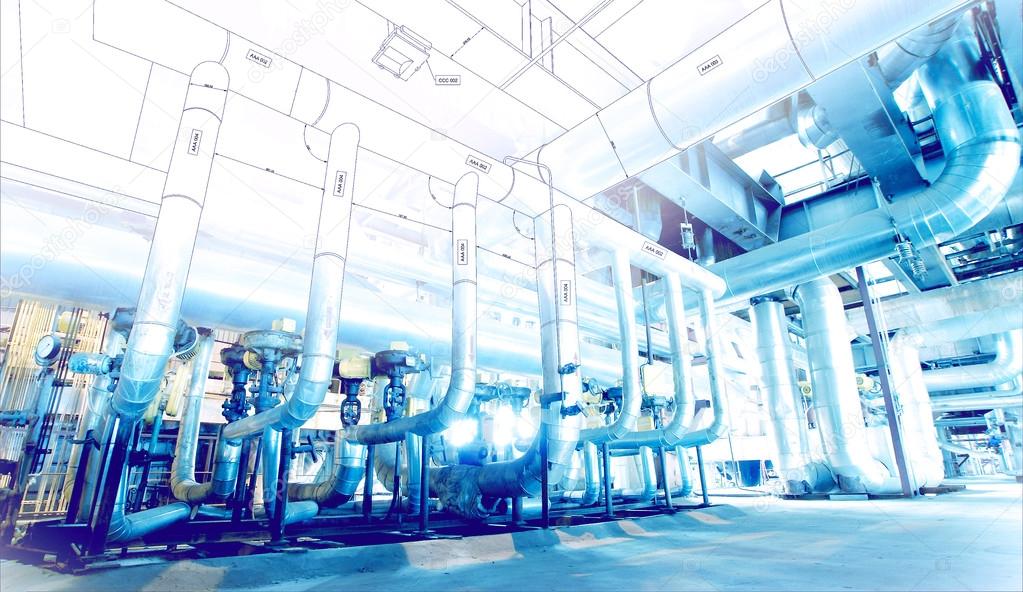DISCIPLINES INVOLVED IN ON-SITE APPLICATION OF MECHANICAL INSTALLATIONS

On-site application of mechanical installations is generally divided into two main categories.
- Piping and Fitting Systems
- Heating, Ventilation, and Air Conditioning (HVAC) Systems
- Fire Protection Systems
- Plumbing Systems
- Cooling Systems
- Automation and Control Systems
- Automatic Control Systems
- Energy Management Systems
-
Mechanical Piping and Fitting Systems
-
Heating, Ventilation, and Air Conditioning (HVAC) Systems generally include the following components :
1.1. Fans : They are used to circulate and clean indoor air
1.2. Ducts : They are used to convey heating, cooling, and ventilation air.
1.3. Heating Units : They are devices that operate with hot water, steam, gas, or electricity. There are also various types, such as ground-source and water-source heating. They are used to heat the indoor spaces of buildings.
1.4. Cooling Units : They are used to cool the indoor spaces of buildings. AHU (Air Handling Unit), Compressor-driven cooling units, and chillers are also connected to them. There are also various types, such as ground-source and water-source cooling.
1.5. Sensors : They are used to measure temperature, humidity, and other variables, and to control the performance of HVAC systems.
1.6. Control Devices : They are used to control and adjust HVAC systems. There are various types such as thermostats and building automation systems.
1.7. Filters : They are used for air filtration and cleaning in HVAC systems.
1.8. Diffusers : They are used to distribute air from ducts into indoor spaces.
1.9. Pipes and Valves : They are used for the circulation and direction of heating and cooling water in HVAC systems.
1.10. Grilles and Fans : They provide fresh air intake for ventilation and exhaust indoor air to the outside.
Fire Protection Systems generally include the following components :
2.1. Fire Detection Devices : They detect the outbreak of fires by monitoring smoke, temperature, and other factors. They provide alerts as part of an automation system or independently, or as a combination of both. They are present within the system as detectors, sensors, and various valve groups.
2.2. Fire Suppression Pipes : They are a system composed of galvanized and threaded connections between DN20-DN50 pipes and grooved connections between black steel pipes DN65 and above, carrying fire suppression materials such as water, foam, dry or chemical powder, etc.
2.3. Fire Sprinkler System : They are nozzles with various temperature and bursting values (K) that provide water during fire intervention. There are various types of them. (Wall-Mounted, Ceiling-Mounted “Vertical and Pendant Type”, Dry Type, Glass front type) These are a few types of them.
2.4. Fire Hydrant System : These are connection points where fire-fighting teams obtain water supply. It is a system integrity that works in conjunction with an underground piping system located inside buildings and around the facility. It provides water to fire extinguishing devices and assists in fire fighting operations.
2.5. Fire pumps and water tank connection system ( Pump Rooms ) : The Fire Pumps and Water Tank Connection System (Pump Rooms) are buildings that house the main pumps and jockey pump, as well as the water storage unit, which carry water and provide the necessary pressure to the fire extinguishing pipes according to the system calculations during firefighting operations.
3. Plumbing Systems generally include the following components :
3.1. Water Supply : Various types of components such as pumps, water storage units, pipes, valves, and water meters are used to connect the sources that require water use inside the building.
3.2. Waste water disposal system : Sink, toilet, shower, bathtub, rain, etc. Components such as pipeline, drains, and drainage devices are used to transport waste waters such as sink, toilet, shower, bath, rain, etc.
3.3. Sewage Systems : The sewage systems include pipes, sub-collectors for collecting wastewater inside the building, septic tanks, and sewage pipes, as well as underground sewer lines, manholes, and other components located outside the building.
3.4. Sink : It includes components such as sinks and accessories used for washing hands, face, and other body parts.
3.5. Toilet : Translated: It includes components such as toilets, flush systems, pipes, septic tanks, etc. used to collect human waste.
3.6. Shower : It includes components such as shower heads, faucets, pipes, and other items used in the bathroom.
3.7. Greywater system : Greywater system is a set of components that recycles and reuses water from sources such as sinks, showers, washing machines, air conditioning condensate, and rainwater through various filtration, cleaning, and chemical treatment processes for reuse in toilet flushing and laundry machines.
4. Cooling Systems typically include the following components :
4.1. Cooling towers : They are large structures used to reduce the temperature of water or other cooling liquids.
4.2. Refrigerant gases : Refrigerant gases are used for cooling. Various gases such as R134a, R404a, R410a are commonly used for cooling.
4.3. Compressors : Compressors are devices that compress refrigerant gases and thereby lower their temperature for cooling purposes.
4.4. Pipes : They are the pipes that transport the refrigerant gases. various materials such as copper, steel, PVC can be used for refrigerant piping.
4.5. Valves : Valves are components that allow for the control of fluids within the cooling system.
4.6. Fans : Large fans are used to circulate the cooling fluids inside the cooling towers.
4.7. Sensors : The temperature, pressure, humidity, etc. in the system. components that measure values
4.8. Control panels : Correct! Control panels are computerized devices used to monitor and control cooling systems.
4.9. Cold storage rooms : Food and pharmaceutical cold storages used for storing products such as food and drugs.